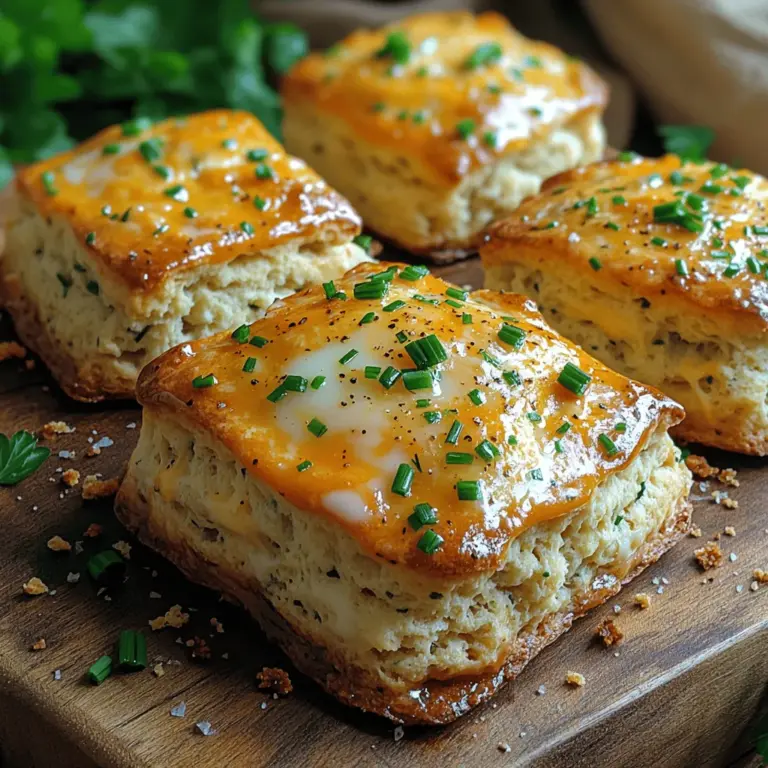Savory Herb Cheddar Scones Recipe
Scones are a beloved baked good that have captured the hearts of many around the world. Originating in British cuisine, these delightful treats have evolved into a versatile option for any meal of the day. While often associated with sweet flavors, scones can be equally delicious and satisfying in their savory form. One standout recipe that exemplifies the savory scone is the Savory Herb Cheddar Scone. With its rich cheese flavor and aromatic herbs, this recipe provides a perfect complement to soups and salads or serves as a delectable snack on its own.
Homemade scones evoke a sense of warmth and comfort, making them a fantastic choice for gatherings, breakfasts, or even a simple afternoon tea. The satisfaction of pulling a batch of freshly baked scones from the oven fills the kitchen with an inviting aroma that beckons everyone to the table. The Savory Herb Cheddar Scone, in particular, combines the richness of sharp cheddar cheese with the freshness of herbs, creating a treat that is both flavorful and satisfying.
Understanding Scones: A Culinary Perspective
To appreciate the beauty of scones, it’s essential to understand what they are and where they come from. Scones are a type of quick bread that are traditionally made with flour, sugar, baking powder, and butter. They have their roots in Scotland and were originally made with oats. Over time, the recipe evolved, and scones became a staple in British afternoon tea, often served alongside clotted cream and jam.
The beauty of scones lies in their versatility. While sweet scones, such as those flavored with berries or chocolate, are popular, savory scones are gaining traction for their bold flavors and hearty qualities. Savory scones can incorporate a variety of ingredients, including cheeses, herbs, and spices, making them perfect for brunch, snacks, or as a side to your favorite soup.
A key element that distinguishes a perfect scone is its texture. Ideal scones should be flaky, tender, and light. Achieving this texture requires a careful balance of ingredients and proper technique. The process of cutting in cold butter, for example, is crucial for creating that desired flakiness. When baked, the butter melts, creating steam that helps the scones rise and develop their characteristic layers.
Ingredients Breakdown
Creating Savory Herb Cheddar Scones requires a careful selection of ingredients that work in harmony to produce an irresistible flavor. Here’s a detailed breakdown of the essential components:
– All-Purpose Flour: The base of the scone, all-purpose flour provides the necessary structure. It has just the right amount of protein to create a tender crumb while allowing the scone to hold its shape.
– Baking Powder: This leavening agent is critical for achieving a light and airy texture. It reacts with moisture and heat, causing the scones to rise beautifully in the oven.
– Salt and Spices: Salt is essential for enhancing flavor. In this recipe, black pepper adds a hint of warmth, while cayenne pepper can introduce a subtle kick, elevating the overall taste.
– Cold Unsalted Butter: The key to a flaky scone, cold butter should be cut into the flour until the mixture resembles coarse crumbs. This process helps to create layers in the scone, contributing to its lightness.
– Sharp Cheddar Cheese: The star ingredient, sharp cheddar adds a robust flavor and creamy texture. As it melts during baking, it infuses the scones with a rich, savory taste.
– Fresh Herbs (Chives and Parsley): Fresh herbs not only enhance the flavor but also bring a vibrant color and aroma to the scones. Chives offer a mild onion flavor, while parsley adds a touch of freshness.
– Buttermilk: The acidity in buttermilk helps to tenderize the dough, resulting in a softer scone. It also reacts with the baking powder to create additional lift.
– Egg Wash: A simple mixture of egg and milk brushed on top before baking gives the scones a beautiful golden finish, making them visually appealing and adding a slight sheen.
Step-by-Step Instructions for Savory Herb Cheddar Scones
Before diving into the mixing and baking, it’s crucial to prepare your workspace. Start by preheating your oven to 400°F (200°C). Proper temperature control is vital for baking, as it ensures that the scones rise correctly and develop a golden crust. A preheated oven allows for immediate heat, which is essential for achieving that wonderful flaky texture.
Once the oven is ready, you can begin assembling your ingredients and preparing to make your Savory Herb Cheddar Scones. This initial setup is the first step toward creating a delicious baked good that is sure to impress your family and friends.
As you prepare to combine your ingredients, gather your mixing bowls, measuring cups, and utensils to streamline the process. The joy of baking lies not only in the final result but also in the experience of creating something special from scratch.

Mixing Dry Ingredients: Techniques for Ensuring an Even Mix
The foundation of any great scone begins with the dry ingredients. To ensure an even mix, start by sifting together the flour, baking powder, baking soda, and salt in a large mixing bowl. Sifting not only helps to aerate the flour but also removes any lumps, resulting in a lighter texture.
Once sifted, use a whisk to further combine the ingredients. This step is crucial as it allows the baking powder and baking soda to be evenly distributed throughout the flour, ensuring that your scones rise uniformly during baking. Take your time with this step—an even mix of dry ingredients contributes significantly to the overall texture and rise of your scones.
Cutting in the Butter: Explanation of the Method to Achieve the Right Texture
Cutting in the butter is a pivotal step in creating the flaky, tender texture that scones are known for. Begin by cubing your cold butter into small pieces, about half an inch in size. Cold butter is essential because it creates steam during baking, which results in flaky layers.
Using a pastry cutter or your fingertips, work the butter into the dry ingredients gently. The goal is to break down the butter until the mixture resembles coarse crumbs with pea-sized pieces of butter still visible. This method ensures that the fat is well-distributed without melting, allowing the scones to rise beautifully.
If you find that your butter is warming up too much, you can chill the mixture briefly in the refrigerator before proceeding to the next step.
Incorporating Cheese and Herbs: Tips for Even Distribution
Once your butter is cut into the flour mixture, it’s time to add the cheese and herbs. For this recipe, shredded sharp cheddar cheese and finely chopped fresh herbs like chives or parsley work wonderfully. To ensure an even distribution, sprinkle the cheese and herbs over the mixture rather than dumping them all in at once.
Gently fold the cheese and herbs into the flour mixture with a spatula or wooden spoon. Be careful not to overmix at this stage; you want the cheese and herbs to be evenly distributed without breaking down the cheese or releasing too much moisture.
Combining Wet and Dry Ingredients: Importance of Not Overmixing
In a separate bowl, whisk together the buttermilk and an egg. Make a well in the center of your dry ingredients and pour in the wet mixture. Using a spatula, gently fold the dry ingredients into the wet until just combined. The key here is not to overmix. Overworking the dough can lead to tough scones instead of the desired light and flaky texture.
You may notice that the dough is a bit shaggy and sticky; this is perfectly normal. If there are still dry bits of flour, it’s okay to leave them—just ensure that the majority of the mixture is combined.
Shaping the Dough: Techniques for Achieving the Ideal Scone Shape
Once the dough has come together, turn it out onto a lightly floured surface. Gently knead the dough just a few times—this is enough to bring it into a cohesive ball without overworking it.
Flatten the dough into a disc about 1 to 1.5 inches thick. For traditional scone shapes, cut the disc into wedges (like a pizza) or use a round cutter for classic round scones. If you prefer uniformity, you can use a bench scraper to cut the dough.
Place the shaped scones onto a baking sheet lined with parchment paper, leaving space between each scone for even baking.
Preparing for Baking: The Significance of the Egg Wash for Presentation
To achieve a beautiful golden-brown crust on your scones, apply an egg wash. Whisk together one egg with a tablespoon of milk or cream, then gently brush the mixture over the top of each scone. This step not only enhances the color but also gives your scones a slight sheen, making them look more appetizing.
Baking Process: What to Look for to Ensure Optimal Doneness
Preheat your oven to 400°F (200°C). Once the oven is hot, place the scones in the center rack and bake for 15-20 minutes. Keep an eye on them as they bake; they should rise beautifully and develop a golden-brown crust. A toothpick inserted into the center of a scone should come out clean when they are done.
If you notice that the tops are browning too quickly, you can loosely cover them with aluminum foil to prevent over-browning while allowing the insides to cook through. The scent of freshly baked scones will fill your kitchen, making it hard to resist the urge to dig in right away.
Cooling and Serving Suggestions: Best Practices for Enjoying the Scones
Once the scones are out of the oven, allow them to cool on the baking sheet for about 5 minutes before transferring them to a wire rack. This cooling process helps to maintain their texture. Serve the scones warm or at room temperature.
These savory herb cheddar scones make a delightful addition to any meal. They can be enjoyed on their own, slathered with butter, or paired with spreads like cream cheese or herbed butter. They also serve beautifully alongside soups or salads, making them a versatile addition to your table.
Flavor Variations and Modifications
If you’re looking to switch up the flavor profile of your savory herb cheddar scones, consider the following substitutions and additions:
– Cheese Substitutions: Instead of cheddar, try using gouda for a smoky flavor, feta for a tangy twist, or even pepper jack for a spicy kick.
– Alternative Herbs: Fresh dill, thyme, or rosemary can impart unique flavors to your scones. Experiment with different combinations to find your favorite.
– Exploring Add-ins: For added texture and taste, consider incorporating sun-dried tomatoes, cooked bacon, or even caramelized onions into the dough. These add-ins can elevate your scones to a whole new level.
Perfect Pairings for Savory Herb Cheddar Scones
To enhance your dining experience, consider these recommended accompaniments and beverages:
– Recommended Accompaniments: These scones pair wonderfully with a variety of soups, such as a hearty tomato basil or a creamy potato leek. They also complement fresh salads, especially those with vinaigrette dressings that contrast with the richness of the scones.
– Beverage Pairings: For a refreshing option, serve your scones with a cup of herbal tea, such as chamomile or mint. If you’re looking for something stronger, a light white wine like Sauvignon Blanc pairs beautifully. Coffee lovers will enjoy a rich, dark brew that complements the savory flavors of the scones.
Storage and Reheating Instructions
To maintain the freshness of your savory herb cheddar scones, follow these storage tips:
– Best Practices for Storing Scones: Store any leftover scones in an airtight container at room temperature for up to two days. For longer storage, freeze the scones in a single layer on a baking sheet, then transfer them to a freezer-safe bag or container. They can be frozen for up to three months.
– Methods for Reheating: For optimal texture, reheat scones in the oven rather than the microwave. Preheat your oven to 350°F (175°C), place the scones on a baking sheet, and heat for about 10-15 minutes, or until warmed through. If using a microwave, heat them for 10-15 seconds, but be aware that this may result in a softer texture.
Conclusion
Baking savory herb cheddar scones is not only a rewarding experience but also a delicious way to bring comfort and joy into your kitchen. The combination of flavorful cheese and fragrant herbs creates a delightful treat that can be enjoyed at any time of the day, from breakfast to dinner.
As you embark on this culinary adventure, remember that these scones are versatile and can be tailored to your taste preferences. So gather your ingredients, roll up your sleeves, and enjoy the ease and satisfaction that comes with creating your own homemade baked goods. Whether you share them with friends and family or savor them all yourself, these scones are sure to become a beloved addition to your recipe repertoire.

